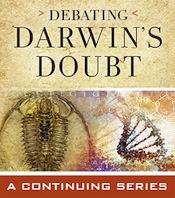 Evolution
Evolution
 Intelligent Design
Intelligent Design
Does Intelligent Design Picture a Living Creature as a "Machine"? Short Answer: No
Speaking of owls as being “engineered,” thoughtful reader Donald sends along this clip from the 1981 film Clash of the Titans that we somehow missed. Bubo the mechanical owl is a cute little guy. It got us thinking about a criticism of the theory of intelligent design that Stephen Talbott raised recently in articles reflecting on ID, Stephen Meyer, and Darwin’s Doubt.
Talbott, based at the Nature Institute in Ghent, NY, is a fascinating thinker on biology. We have commented on his writing for The New Atlantis in the past. See Tom Bethell’s article “‘Life All the Way Down’: Stephen Talbott’s Biological Vision.” Also here, here and here. Bethell thanked Talbott for a “highly rewarding” series of essays that
seems to aim at nothing less that a new paradigm for the study of life…. [He] argues persuasively that organisms are wholes and cannot be thought of as assembled in machine-like fashion — one part mechanically added to another.
 Talbott sees agency not only at the level of a whole, purpose-driven creature going about its business, but at every level of life. He has used the term “performance,” as in a dance performance, to describe the inner workings of the cell. A colleague characterizes Talbott’s view as “Goethian pantheism.” He’s not short of provocation and, agree with him or not, he repays careful reading of his articles.
Talbott sees agency not only at the level of a whole, purpose-driven creature going about its business, but at every level of life. He has used the term “performance,” as in a dance performance, to describe the inner workings of the cell. A colleague characterizes Talbott’s view as “Goethian pantheism.” He’s not short of provocation and, agree with him or not, he repays careful reading of his articles.
In a recent post, “RNA: Dancing with a Thousand Partners,” he remarks on the “resurgent community of intelligent design theorists” whose “critiques of conventional evolutionary theory have grown increasingly sharp and on-target in recent years. I hope to have more to say about all this shortly.” Thank you, and yes please do.
He does offer this criticism of ID, however:
Rather than seeing an intelligence at work in the organism as a living capacity, they would rather reserve such intelligence for God, with the organism reduced to a kind of machine that God may occasionally tinker with (miraculously, it would seem) from without.
The part about God is unfair since, whatever individual advocates of ID may think about the source of design in nature, the theory of ID itself is sincerely agnostic on that. It recognizes that the journey of scientific discovery that may plumb the mystery of life and its origins is in its infancy — not, as Darwinists seem to think, its senility. (See “Intelligent Design and the ‘Deep Future.’“)
What about the idea that we see an organism as a “machine”? Talbott says the same in his post on Stephen Meyer’s book (“A Sectarian Quarrel: Intelligent Design and Neo-Darwinism.”). He seems to have had Darwin’s Doubt in mind in the warm comment about how ID has “grown increasingly sharp and on-target.”
He says of Meyer’s book:
[A]s an assessment of the challenges facing evolutionary theorists on several fronts today, the book seems to me at least as creditable as many productions by contemporary neo-Darwinian biologists. And, in his attempt to convince the reader through calm argument, the author rises above the shrill, apparently frightened, and scarcely scientific rhetoric we’ve been hearing for years from some of the more militant, self-identified atheists and anti-intelligent design types.
That is gratifying, but then he registers again the point about the organism as a “machine.”
I had hoped that Meyer would avoid making machines out of his organisms, for two reasons. First, the usage simply doesn’t work. As I have tried to show elsewhere, the organism is not machine-like and it also is far from being, in any part, a computer. Second, and more important for present purposes: the machine metaphor invites — almost demands — that we inquire about the designer of the machine. By appealing to such an external agency, one ignores the living agency of the organism itself.
Our response? First of all, Meyer doesn’t say organisms are “machines” or “computers.” To say that living things include what appear to be machines and computers is very different from making a blunt equation.
Moreover, something could be machine-like in certain relevant ways without being a machine just like a human-manufactured machine. Whatever an organism is, it’s at least as teleologically derived, as laden with specified complexity, as any man-made machine. Talbott is concerned that we will shoehorn our idea of an organism into a simplistic and mechanistic understanding of the machine. But we don’t.
Based on a reading of his articles in The New Atlantis, his underlying point is this: Unlike human machines, which are each constructed from parts and don’t produce after their kind (at least not yet), organisms are internally self-directed. The human being, for instance, starts as a small, relatively undifferentiated fertilized egg, zygote, then embryo, and self-develops and differentiates from the inside. This is indeed an astonishing thing, and distinguishes even the simplest organisms from the most exquisite man-made machines. His insight here is perfectly compatible with ID.
In addition, Talbott’s view seems to require that we attribute agency to the developing organism itself. But clearly a sponge isn’t directing its own development as a conscious agent. While it exhibits internal self-direction, it calls out for an ultimate agent as an explanation outside itself.
This is what Talbott wants to avoid, but it’s clearly the most natural inference.

